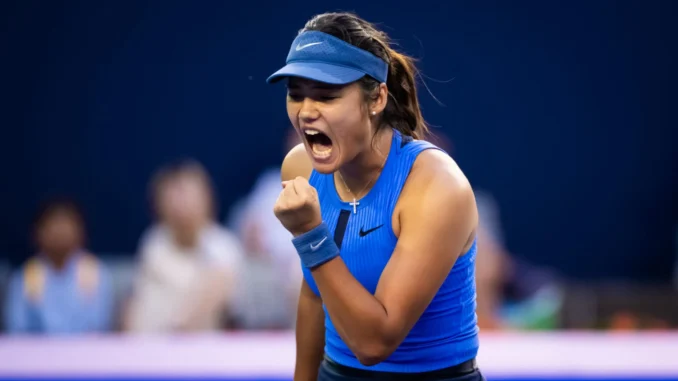
In the sweltering heat of Beijing’s China Open, under lights that cast long shadows across the hard courts, Emma Raducanu pushed world number one Jessica Pegula to the brink. It was a match that had everything—a gritty comeback, razor-sharp rallies, and heart-stopping drama. Raducanu, the 22-year-old British sensation, clawed her way back from a set down, forcing a tiebreak in the second and even holding three match points in the decider. The crowd held its breath as she unleashed blistering forehands and clever net play, her movement fluid despite the grueling conditions. But in a cruel twist, Pegula, fresh off a draining Billie Jean King Cup final, dug deep, saving every point and storming to a 6-3, 6-7(5), 6-0 victory. For Raducanu, it was a bitter pill, echoing her recent heartbreak at the Korea Open where she squandered match points against Barbora Krejcikova in a 4-6, 7-6(10), 6-1 defeat.
Yet, amid the sting of these near-misses, a quiet revolution is brewing in Raducanu’s game—one that’s catching the eye of seasoned observers. Former world number nine CoCo Vandeweghe, a two-time Grand Slam doubles finalist and no stranger to the tour’s highs and lows, couldn’t hide her admiration. Speaking on the Inside-In Tennis Podcast, the American, now a sharp tennis analyst, zeroed in on the subtle shifts she’s witnessed since Raducanu brought on her latest coaching addition. “I think it’s challenging to play in Asia with the conditions,” Vandeweghe noted, acknowledging the relentless humidity and jet lag that test even the fittest players. “And we’re seeing some players relish those, one of them being Raducanu.”
What truly lit up Vandeweghe’s commentary, though, was the visible evolution in Raducanu’s approach. Just weeks into her partnership with Francisco Roig—the Spaniard who once shaped Rafael Nadal’s early career as a junior coach—Raducanu has started to string together moments of sustained brilliance. Roig, known for his meticulous technical tweaks and emphasis on mental resilience, joined Raducanu’s team in August 2025, right before the US Open. It was a move born of necessity; Raducanu’s post-2021 US Open triumph has been a rollercoaster of injuries, form dips, and coaching changes. From Nigel Sears to Andrew Richardson, and more recently Mark Petchey, she’s cycled through mentors in search of stability. But with Roig, there’s a sense of synergy—a coach who blends Nadal’s intensity with a tailored focus on Raducanu’s explosive baseline game.
“I’m impressed with Emma Raducanu with the new team and the new coach she has with what she’s been able to do in terms of pushing top players more consistently,” Vandeweghe enthused. “She’s actually playing more consistent tennis.” It’s a stark contrast to the erratic bursts that defined Raducanu’s 2024 season, where injuries sidelined her for chunks of the year and left her scrambling for momentum. This year, 2025, has shown flickers of the old magic: a third-round run at the Australian Open, where she fell to Iga Swiatek in straight sets but not without making the world number one sweat; a solid quarterfinal showing in Indian Wells; and now, these valiant stands against elite competition in Asia. Currently ranked 32nd in the world, Raducanu’s serve has sharpened, her backhand slicing with renewed venom, and her court coverage feeling more instinctive. Vandeweghe sees it as the foundation for something bigger. “So that’s going to be a good storyline in Australia, to see how she can perform when she’s worked with the new coach,” she added, her voice laced with genuine excitement.
Raducanu’s journey has always been one of prodigious talent meeting the harsh realities of professional tennis. At just 18, she stormed to the 2021 US Open title as a qualifier—the first British woman to claim a Grand Slam in 45 years—captivating the world with her poise and power. But the spotlight brought scrutiny, surgeries on both ankles and a back issue derailed her momentum, and whispers of burnout crept in. She’s spoken candidly about the mental toll, the pressure to replicate that fairy-tale run. Yet, at 22, with a maturing perspective and a support system that’s finally clicking, Raducanu is rewriting her narrative. Roig’s arrival feels like the missing piece: his track record with Nadal speaks to building champions from the ground up, emphasizing footwork drills and strategic depth that could unlock Raducanu’s all-court potential.
As the autumn sun sets on the Asian swing, Raducanu’s gaze is already fixed ahead. The Wuhan Open beckons on October 6—the final WTA 1000 event of the year, a glittering showcase in Hubei province where the world’s best converge on fast, unforgiving courts. For Raducanu, it’s more than a tournament; it’s a launchpad. With no points to defend from last year’s absence due to injury, a deep run here could catapult her back into the top 25, securing a seeded berth at the 2026 Australian Open. Imagine it: Melbourne’s rod laver Arena, the sea of green and gold, and Raducanu, steadier than ever, channeling the lessons from Beijing’s near-miss into a statement week.
Vandeweghe’s endorsement isn’t just flattery—it’s a nod to the grit that’s always simmered beneath Raducanu’s surface. In a sport where consistency is the ultimate currency, these signs of growth are gold. Pegula’s resilience in that China Open thriller was admirable, but so too was Raducanu’s refusal to fade quietly. As the off-season looms, whispers of a resurgent Brit are growing louder. With Roig in her corner and believers like Vandeweghe cheering from afar, Emma Raducanu isn’t just competing—she’s evolving. The slams of 2026? They might just witness the return of a queen.
Leave a Reply